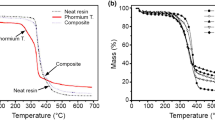Abstract
The current work examines the durability of composites reinforced with glass fibre woven fabric as well as non-crimp fabrics (NCF) immersed in water at 43, 65 and 93 °C for up to 2.5 years. Low velocity normal impact has been induced at various time intervals before and after water immersion at energy levels of 2.5, 5 and 10 J. Following impact the plates were tested statically in compression to determine the residual strength for assessment of damage tolerance. The compression strength suffered significant reductions from the water absorption and the low velocity impact with values being dependent to the time of immersion and the water temperature. A parallel behaviour was monitored, in terms of strength reduction over time, of plates impacted prior to water immersion with the plates that contain no damage. For specimens where impact damage introduced after water immersion lower compression-after-impact (CAI) strength was observed at the same energy levels. An increase in damage diameter was evident, regardless the reinforcement type, though the gradually produced greater density of through thickness damage was responsible for the significant lower compression strength values. The presence of 0° fibres for the NCF composites as the main load bearing element dictated the sensitivity to impact as well as the corresponding residual strength. For composites with woven reinforcement, damage was contained and localized by the fabric weave and effective stress redistribution seemed to be the mechanism for the relatively higher residual strengths obtained. A semi-empirical model has been used with high accuracy in fitting the given experimental data and draw conclusions from the comparisons.



















Similar content being viewed by others
References
Tzetzis D, Hogg PJ (2008) Mater Des 29(2):436
De Freitas M, Reis L (1998) Compos Struct 42(4):365
Xiong Y, Poon C, Straznicky PV, Vietinghoff H (1995) Compos Struct 30(4):357
Baker AA, Jones R, Callinan RJ (1985) Compos Struct 4(1):15
NASA (1983) Standard test for toughened resin composites. NASA Reference Publication 1092
Boeing (1988) Advanced composite compression test. Boeing Specification Support Standard BSS 7260
SACMA (1994) Recommended Methods SRM 2-94. Suppliers of Advanced Composites Materials Association
Curtis PT (1988) CRAG test methods for the measurements of the engineering properties of fibre reinforced plastics. Royal Aerospace Establishment Technical Report TR88012
Delfosse D, Poursartip A, Coxon BR, Dost EF (1995) Compos Mater: Fatigue Fract 5:333. ASTM STP 1230
Hawyes VJ, Curtis PT, Soutis C (2001) Compos Part A: Appl Sci Manuf 32(9):1263
Duarte A, Herszberg I, Paton R (1999) Compos Struct 47(1–4):753
Dorey G, Bishop SM, Curtis PT (1985) Compos Sci Technol 23(3):221
Habib FA (2001) Compos Struct 53:309
Bishop SM (1985) Compos Struct 3:295
Kim J, Shioya M, Kobayashi H, Kaneko J, Kido M (2004) Compos Sci Technol 64:2221
Kim JK, Sham ML (2000) Compos Sci Technol 60:745
Bibo GA, Hogg PJ (1998) Key Eng Mater 141–143:93
Cantwell WJ, Morton J (1991) Composites 22(5):347
Bank LC, Gentry TR, Barkatt A (1995) J Reinf Plast Compos 14:559
Berketis K, Tzetzis D (2009) J Mater Sci 44:3578. doi:10.1007/s10853-009-3485-9
Morii T, Hamada H, Maekawa Z, Tanimoto T, Hirano T, Kiyosumi K (1983) Polym Compos 1:3744
Morii T, Hamada H, Maekawa Z, Tanimoto T, Hirano T, Kiyosumi K (1994) Polym Compos 15:206
Berketis K, Tzetzis D, Hogg PJ (2008) Mater Des 29:1300
Shoeppner GA, Abrate S (2000) Compos Part A 31:903
Sanchez-Saez S, Barbero E, Zaera R, Navarro C (2005) Compos Sci Technol 65:1911
Nettles AT, Hodge AJ (1991) Compression-after-impact testing of thin composite materials. In: Proceedings of the 23rd international SAMPE technical conference, pp 177–183
Liu D, Raju BB, Dang X (1998) Int J Impact Eng 21:837
Sjoblom PO, Hwang B (1989) Compression-after-impact: the $5000 data point. In: International SAMPE Symposium Exhibition, vol 34, pp 1411–1421
Prichard JC, Hogg PJ (1990) Composites 21:503
Prichard JC, Hogg PJ, Stone DL (1992) A miniaturized post impact compression test. Department of Materials, Queen Mary and Westfield College in co-operation with British Aerospace and CIBA Geigy, pp 1–8
Zhou G (1996) Compos Struct 35:171
Berketis K, Tzetzis D, Hogg PJ (2009) Polym Compos 30(8):1043
Berketis K, Tzetzis D (2009) In: Lechkov M, Prandzheva S (eds) Encyclopedia of polymer composites. Nova Science Publishers, Inc, New York. ISBN: 978-1-60741-717-0
Schutte CL (1994) Mater Sci Eng R 13:265
Belan F, Bellenger V, Mortaigne B (1997) Polym Degrad Stab 56:93
Caprino G (1983) J Compos Mater 18:508
Komai K, Minoshima K, Yamasaki H (1995) Evaluation of low-velocity impact induced delamination by scanning acoustic microscope and influence of water absorption on delamination and compression after impact of CFRP. In: Emri I, Knauss WG (eds) First international conference on the mechanics of time dependent materials, SEM, pp 287–292
Author information
Authors and Affiliations
Corresponding author
Rights and permissions
About this article
Cite this article
Berketis, K., Tzetzis, D. The compression-after-impact strength of woven and non-crimp fabric reinforced composites subjected to long-term water immersion ageing. J Mater Sci 45, 5611–5623 (2010). https://doi.org/10.1007/s10853-010-4626-x
Received:
Accepted:
Published:
Issue Date:
DOI: https://doi.org/10.1007/s10853-010-4626-x




